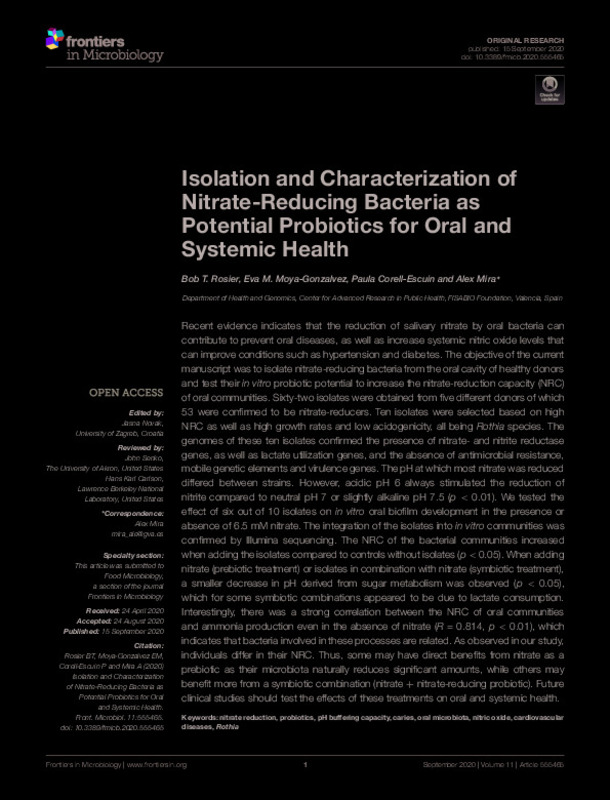JavaScript is disabled for your browser. Some features of this site may not work without it.
Buscar en RiuNet
Listar
Mi cuenta
Estadísticas
Ayuda RiuNet
Admin. UPV
Isolation and Characterization of Nitrate-Reducing Bacteria as Potential Probiotics for Oral and Systemic Health
Mostrar el registro sencillo del ítem
Ficheros en el ítem
| dc.contributor.author | Rosier, Bob T.
|
es_ES |
| dc.contributor.author | Moya-Gonzalvez, Eva M.
|
es_ES |
| dc.contributor.author | Corell-Escuin, Paula
|
es_ES |
| dc.contributor.author | Mira, Alex
|
es_ES |
| dc.date.accessioned | 2024-05-06T18:07:20Z | |
| dc.date.available | 2024-05-06T18:07:20Z | |
| dc.date.issued | 2020-09-15 | es_ES |
| dc.identifier.issn | 1664-302X | es_ES |
| dc.identifier.uri | http://hdl.handle.net/10251/203994 | |
| dc.description.abstract | [EN] Recent evidence indicates that the reduction of salivary nitrate by oral bacteria can contribute to prevent oral diseases, as well as increase systemic nitric oxide levels that can improve conditions such as hypertension and diabetes. The objective of the current manuscript was to isolate nitrate-reducing bacteria from the oral cavity of healthy donors and test theirin vitroprobiotic potential to increase the nitrate-reduction capacity (NRC) of oral communities. Sixty-two isolates were obtained from five different donors of which 53 were confirmed to be nitrate-reducers. Ten isolates were selected based on high NRC as well as high growth rates and low acidogenicity, all beingRothiaspecies. The genomes of these ten isolates confirmed the presence of nitrate- and nitrite reductase genes, as well as lactate utilization genes, and the absence of antimicrobial resistance, mobile genetic elements and virulence genes. The pH at which most nitrate was reduced differed between strains. However, acidic pH 6 always stimulated the reduction of nitrite compared to neutral pH 7 or slightly alkaline pH 7.5 (p< 0.01). We tested the effect of six out of 10 isolates onin vitrooral biofilm development in the presence or absence of 6.5 mM nitrate. The integration of the isolates intoin vitrocommunities was confirmed by Illumina sequencing. The NRC of the bacterial communities increased when adding the isolates compared to controls without isolates (p< 0.05). When adding nitrate (prebiotic treatment) or isolates in combination with nitrate (symbiotic treatment), a smaller decrease in pH derived from sugar metabolism was observed (p< 0.05), which for some symbiotic combinations appeared to be due to lactate consumption. Interestingly, there was a strong correlation between the NRC of oral communities and ammonia production even in the absence of nitrate (R= 0.814,p< 0.01), which indicates that bacteria involved in these processes are related. As observed in our study, individuals differ in their NRC. Thus, some may have direct benefits from nitrate as a prebiotic as their microbiota naturally reduces significant amounts, while others may benefit more from a symbiotic combination (nitrate + nitrate-reducing probiotic). Future clinical studies should test the effects of these treatments on oral and systemic health. | es_ES |
| dc.description.sponsorship | AM was supported by a grant from the European Regional Development Fund and Spanish Ministry of Science, Innovation and Universities with the reference RTI2018-102032-B-I00, as well as, a grant from the Carlos III Health Institute with the reference DTS16/00230 and a grant from the Valencian Innovation Agency with the reference INNVAL20/19/006. BR was supported by a grant from the Spanish Ministry of Science, Innovation and Universities with the reference Bio2015-68711-R. | es_ES |
| dc.language | Inglés | es_ES |
| dc.publisher | Frontiers Media SA | es_ES |
| dc.relation.ispartof | Frontiers in Microbiology | es_ES |
| dc.rights | Reconocimiento (by) | es_ES |
| dc.subject | Nitrate reduction | es_ES |
| dc.subject | Probiotics | es_ES |
| dc.subject | PH buffering capacity | es_ES |
| dc.subject | Caries | es_ES |
| dc.subject | Oral microbiota | es_ES |
| dc.subject | Nitric oxide | es_ES |
| dc.subject | Cardiovascular diseases | es_ES |
| dc.subject | Rothia | es_ES |
| dc.title | Isolation and Characterization of Nitrate-Reducing Bacteria as Potential Probiotics for Oral and Systemic Health | es_ES |
| dc.type | Artículo | es_ES |
| dc.identifier.doi | 10.3389/fmicb.2020.555465 | es_ES |
| dc.relation.projectID | info:eu-repo/grantAgreement/AEI/Plan Estatal de Investigación Científica y Técnica y de Innovación 2017-2020/RTI2018-102032-B-I00/ES/EFECTOS LOCALES Y SISTEMICOS DE LA MICROBIOTA ORAL/ | es_ES |
| dc.relation.projectID | info:eu-repo/grantAgreement/MINECO//BIO2015-68711-R/ES/PAPEL DE LA MICROBIOTA ORAL EN LA SALUD HUMANA/ | es_ES |
| dc.relation.projectID | info:eu-repo/grantAgreement/MINECO//DTS16%2F00230/ES/Desarrollo de un test de diagnóstico del Riesgo Cardiovascular Mediado por Microorganismos (RICAMM) y búsqueda de probióticos protectores/ | es_ES |
| dc.relation.projectID | info:eu-repo/grantAgreement/AVI//INNVAL20%2F19%2F006/ | es_ES |
| dc.rights.accessRights | Abierto | es_ES |
| dc.description.bibliographicCitation | Rosier, BT.; Moya-Gonzalvez, EM.; Corell-Escuin, P.; Mira, A. (2020). Isolation and Characterization of Nitrate-Reducing Bacteria as Potential Probiotics for Oral and Systemic Health. Frontiers in Microbiology. 11. https://doi.org/10.3389/fmicb.2020.555465 | es_ES |
| dc.description.accrualMethod | S | es_ES |
| dc.relation.publisherversion | https://doi.org/10.3389/fmicb.2020.555465 | es_ES |
| dc.type.version | info:eu-repo/semantics/publishedVersion | es_ES |
| dc.description.volume | 11 | es_ES |
| dc.identifier.pmid | 33042063 | es_ES |
| dc.identifier.pmcid | PMC7522554 | es_ES |
| dc.relation.pasarela | S\430773 | es_ES |
| dc.contributor.funder | Agencia Estatal de Investigación | es_ES |
| dc.contributor.funder | Agència Valenciana de la Innovació | es_ES |
| dc.contributor.funder | Ministerio de Economía y Competitividad | es_ES |








